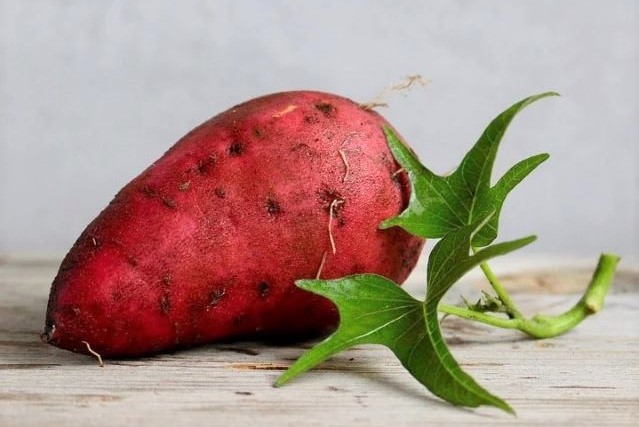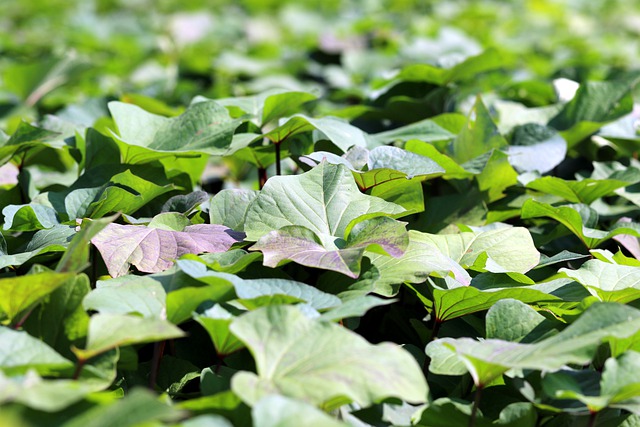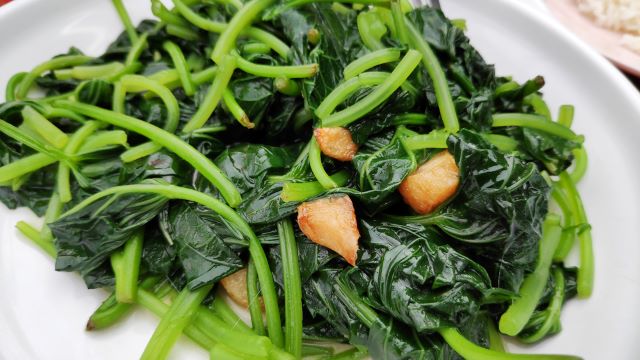So you’ve managed to grow a crop of sweet potatoes and you’re looking at the long, leafy expanse of vines covering your garden and wondering if the sweet potato leaves are edible? The good news is you can eat sweet potato leaves. Read on to learn why you should add this veggie to your next meal, how to cook sweet potato leaves and recipe ideas.

Table of Contents
- Can You Eat Sweet Potato Leaves?
- How to Harvest Sweet Potato Leaves for Eating
- Does Harvesting Sweet Potato Leaves Hurt the Tuber?
- When Are Sweet Potato Leaves Ready to be Harvested?
- How Big Should Sweet Potato Leaves be for Eating?
- What Do Sweet Potato Leaves Taste Like?
- How to Eat Sweet Potato Leaves
- Sweet Potato Leaf Recipes
- Health Benefits of Sweet Potato Leaves
Can You Eat Sweet Potato Leaves?
Sweet potato leaves can and should be eaten. While the sweet potato tuber may be the star of the show, the sweet potato leaves pack a bonus nutritional punch that shouldn’t be missed.
Scientifically named Ipomoea Batatas, sweet potatoes are a starchy root vegetable packed with fiber, antioxidants, vitamins B, C, and A, and minerals like iron, selenium, and calcium – but that’s not all. Their leaves are also packed with amazing nutrients that you don’t want to miss out on.
That’s great news for nutrient-lovers out there because every part of the sweet potato plant is edible. Yes, that means you don’t need to pass up those delicious green vines.
The leaf of the sweet potato offers extra health benefits that aren’t included in the potato itself.
Sweet potato leaves can be used in a myriad of ways, much like spinach or turnip greens.
How to Harvest Sweet Potato Leaves for Eating

Harvesting sweet potato leaves can be done throughout the growing season. And actually, harvesting the sweet potato leaves and vines can help keep the plants under control. Left unchecked, sweet potato vines can spread and vigorously cover large areas of up to 20 ft (6m) per plant!
As well as harvesting sweet potato leaves during their growing season, when it comes time to dig up your sweet potatoes, you can collect all the additional leaves for eating that haven’t died off as yet.
Be aware when harvesting the sweet potato leaves, that the vines and leaves are filled with sticky sap. This can irritate the skin, though I’ve never been bothered by it. However, you can wear gloves if you have sensitive skin and for easier cleanup.
Does Harvesting Sweet Potato Leaves Hurt the Tuber?
No, properly harvesting sweet potato leaves does not hurt the sweet potato tuber. In fact, harvesting the leaves can help the sweet potato grow.
Sweet potatoes need adequate sunlight and space to grow to their full potential, and harvesting the leaves is an easy way to make that happen.
When harvesting, be sure to leave plenty of stem and leaf on the sweet potato so it can continue to grow. For a healthy sweet potato vine, there will be plenty of growth during the season for harvesting leaves. Remember, vines can grow as large as 20 ft (6 m).
When Are Sweet Potato Leaves Ready to be Harvested?
Before harvesting sweet potato leaves, make sure the vines are adequately established and growing well. Then anytime during and before the end of the growing season is the perfect time to harvest sweet potato leaves.
Sweet potatoes take between 90 to 120 days to maturity and are normally in the ground from May until the first frost of the winter season. The sweet potato vine will turn yellow on its ends and starts to die off, which signifies that the sweet potato is ready to be dug up.
How Big Should Sweet Potato Leaves be for Eating?
Sweet potato leaves vary in size between 2-5 inches (5-13 cm) in length depending on the variety. And they can be picked in any size.
Newer sweet potato leaves and vine tips will be more tender and perfect for eating raw in salads. This is usually the sweet potato leaves along the top 4 inches (10 cm) of the vine.
While mature sweet potato leaves can be harvested when they are older for cooking.
What Do Sweet Potato Leaves Taste Like?
Sweet potato leaves have a mild flavor. When eaten raw, sweet potato greens can be a little bitter but younger leaves will be milder and sweeter. When cooked, the flavor of sweet potato leaves turns mild, like that of spinach or water spinach.
How to Eat Sweet Potato Leaves

Firstly, it’s a good idea to give sweet potato leaves a good wash to remove any sap before eating them. Especially if you would like to eat them raw.
Like many other greens, the leaves of sweet potatoes can be a little bitter. To cut down on the bitterness, you can boil the leaves in a small amount of water. Boiling the sweet potato leaves does cause them to lose some of their vitamins, but some vitamins are in fact unlocked with heat.
A common way to eat sweet potato leaves is to treat them like spinach and cook them accordingly.
Sauté the sweet potato leaves in butter and garlic for a stir fry, or use them as a garnish on any dish. These also go well paired with sauces.
Try adding some young sweet potato leaves into a mixed green salad. Remember, uncooked leaves can be a little bitter, so add other leafy greens to balance it out until you are familiar with the taste.
You can also add sweet potato leaves to smoothies. So swap out kale and spinach during the growing season and make a sweet potato leaf smoothie.
Sweet Potato Leaf Recipes
There are many ways to incorporate sweet potato leaves into meals, but here are some recipes to get you started.
Sweet Potato Greens in Coconut Cream – from Love and Olive Oil. A deliciously creamy way to eat sweet potato leaves with the addition of coconut cream. This recipe also uses ginger, turmeric, chili, lemongrass, and soy sauce for the flavors of mild and creamy curry.
Easy Vegetable Stir-Fry – From Nyonya Cooking. This stir-fry is like any other, except they use sweet potato leaves in place of other leafy vegetables. Simply add your desired amount of leaves into a hot pan with oil and garlic, and sauté. Add vegetables, and continue stirring until they’re soft.
Vietnamese Sweet Potato Leaves Soup – from Vicky Pham. This yummy soup uses dried shrimp along with spices and a whole bunch of fresh sweet potato leaves.
Sweet Potato Leaf Juice – From Simply Bakings. This juice is great to make if you are boiling the sweet potato leaves for any reason – it utilizes the leftover water. Use the nutrients accumulated in the boiled water to make a juice. Add lemon, sugar, and other flavors to taste.
Sambal Sweet Potato Leaf – from Noob Cook. If you love spice then this Sambal recipe is for you. Combined with delicious spice and dried shrimp, sweet potato leaves are given some heat.
Sweet Potato Leaves Salad Recipe – from Panlasang Pinoy. Although a salad, this recipe blanches the sweet potato leaves and combines them with tomato, onion, and ginger. Serve as a starter to delicious served with fish as a main.
Sweet Potato Leaves Raita – from One Wholesome Meal. As a delicious side dish to Indian cuisine, this recipe for Raita uses cooked sweet potato leaves. Which is a nice twist on the uncooked indigents usually added to make Raita.
Health Benefits of Sweet Potato Leaves
As we have seen, the leaves of the sweet potato offer nutrients that aren’t found in the sweet potato tubers. The Louisiana State Agricultural Center has found that these nutrients include vitamins A, C, and K, riboflavin, thiamin, folic acid, niacin, copper, potassium, and iron.
These key nutrients provide benefits to the body in many ways. Health benefits include:
- Improving bone density
- Reducing pain during menstruation
- Reducing inflammation
Improving Bone Density
Vitamin K is a vitamin that helps maintain the calcium in bones, which in turn reduces the chances of osteoporosis. It’s essential in using calcium for bone formation.
It has positive effects on calcium balance, and consuming vitamin K lowers the chances of bone fractures in post-menopausal women. As a further benefit, vitamin K is said to help to prevent sprained ankles and recover broken bones.
Reducing Pain During Menstruation
A vitamin K deficiency can worsen menstruation symptoms, so it’s important to pack that nutrient in as much as possible. Vitamin K regulates hormone function, clots blood, prevents excessive bleeding, and relieves the pain of PMS symptoms.
Reducing Inflammation
The antioxidant properties of sweet potato leaves eradicate free radicals from the body, which cuts down on inflammation. Vitamin A also assists, as it reduces the chance of food allergies and overreactions.
Further reading:
- Eating Raw Sweet Potatoes With Recipe Ideas
- How to Start Sweet Potato Slips for Growing Sweet Potatoes
- Why Are My Sweet Potato Leaves Turning Yellow?
- Are Pumpkin Leaves Edible? (And How to Eat Pumpkin Leaves)
- Eating Warrigal Greens: Cooking and Recipes Ideas
- Tips For Eating Dandelion Greens, Flowers, and Roots
- Are Ginger Leaves Edible? (And how to eat them!)
- Eating Turnip Greens With Recipe Ideas
